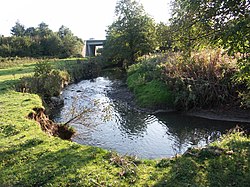| Afon Clun | |
|---|---|
 The Afon Clun near Talbot Green | |
 | |
| Etymology | Welsh: afon = river, clun (obsolete) = meadow[1] |
| Location | |
| Country | Wales |
| Physical characteristics | |
| Source | |
| • location | The Garth (Mynydd y Garth), City and County of Cardiff |
| • coordinates | 51°32′30″N 3°18′10″W / 51.54167°N 3.30278°W |
| • elevation | 260 m (850 ft) |
| Mouth | |
• location | River Ely (Afon Elái), Pontyclun, Rhondda Cynon Taf |
• coordinates | 51°31′38.35″N 3°23′26″W / 51.5273194°N 3.39056°W |
• elevation | 42 m (138 ft) |
| Length | 23 km (14 mi) |
| Basin size | 32 km2 (12 sq mi) |
| Discharge | |
| • location | Pontyclun |
| Basin features | |
| Tributaries | |
| • left | Nant Mwyndy |
| • right | Nant Myddlyn |
Afon Clun (Welsh for 'River Clun') is a 14-mile (23 km) long tributary of the River Ely (Welsh: Afon Elái), in the counties of Cardiff and Rhondda Cynon Taf, Wales. Its bedrock is predominantly of sandstone. Beginning on the western slope of The Garth (Mynydd y Garth) the river is fast-flowing, in clear shallow water with a hard substrate, flowing to the south of Llantrisant and generally west to its confluence with the River Ely at Pontyclun, falling 715 feet (218 m) over its course.
The river contains species such as stone loach, lamprey, eel, roach, chub and bullhead, and the Afon Clun valley is home to many species, including dragonflies and damselflies, badger, and the marsh fritillary butterfly, as well as the European Protected Species – bats, dormouse, otter and great crested newt. Birds in the area include bullfinch, kingfisher, linnet, reed bunting, skylark, and song thrush.
The valley is at risk of flooding between Cross Inn and Pontyclun and the river is liable to overflow its northern bank along its one-and-a-half-mile (2.4 km) length downstream from the main A4119 (Tonypandy to Cardiff Bay (Bae Caerdydd)) road at Talbot Green (Tonysguboriau) to Pontyclun, providing a wetland wildlife habitat.
Many archeological sites are close to the river, from the Bronze Age tumuli on The Garth and an Iron Age hill fort at Rhiwsaeson, to the more recent industrial archeology of coal mines.
- ^ "BBC Wales – What's in a name – Place name search". BBC Wales website. BBC Wales. 7 October 2008. Archived from the original on 13 November 2012. Retrieved 7 October 2008.